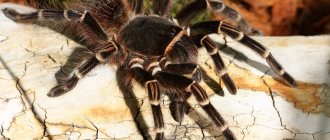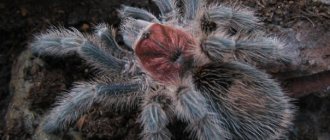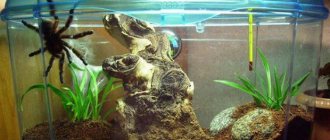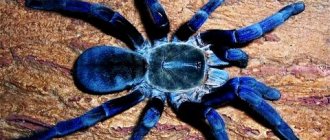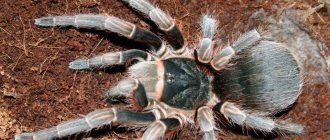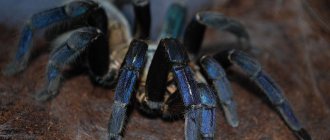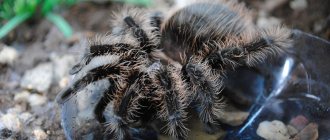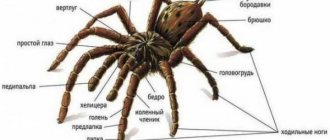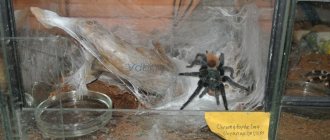Spiders 08/07/20205841 views
Poecilotheria metallica is rightfully considered one of the most beautiful and rare tarantula spiders. The dream of many keepers is to have this species in their collection. The habitat area, judging by a few literary sources, is in the South-South-East of India (Gooty, Madras), but it is not clearly defined and has gaps due to human economic activity and the destruction of natural habitats.
Terrarium 30*30*30 cm PetPetZone (spider)
The body structure is characteristic of all representatives of the genus. Adult sizes range from 15 to 21 cm in paw span. Females are more massive, however, in habit, as a rule, they are smaller before adult molt. The coloring is very bright, metallic blue with gray-white patterns on the carapace and abdomen, and on the legs, especially on their back side, there are also yellow stripes. Individuals from the southern range have a black carapace, because of this there is an opinion about two color variations. The intense blue coloration is most pronounced in subadult males. Females are less intensely colored throughout their lives. One of the nice things about metallics is the absence of irritating hairs.
Description
The blue tarantula got its name due to its bright blue color. However, this color only appears in bright light. The usual color of this spider is brown, gray, slightly bluish with a metallic tint. It turns bright blue after molting, gradually losing brightness towards the next molting.
The size of the individual is 6-7 cm, with a paw span of 16-17 cm. Females of this species are usually larger than males.
On a note! The largest metallic tarantula is 21 cm with a paw span.
The spider has complex patterns of white or yellowish color on its back. There are also such spots on the limbs. Before molting, these spots on the lower legs become bright yellow or yellow-orange.
Spreading
The metallic tree tarantula is found only in the state of Andhra Pradesh in India in the vicinity of the cities of Nandyal and Giddaluru. The total area of its habitat does not exceed 100 square kilometers.
The animal was first discovered in the bungalow of a railway engineer on the northwestern line of the Madras Railway in the town of Gooty, located a hundred miles from its habitat. Presumably it got there after traveling on a train. Subsequently, he was never found in this area again.
The caught specimen was described in 1899 by British arachnologist Reginald Pocock. For a long time, the species was considered extinct, until 102 years later it was found again in the jungle by Canadian zoologist Rick West and British naturalist Andrew Smith. The local population calls it a blue or blue spider.
Pecilotheria metallica is included in the list of the 100 most endangered species of the world's flora and fauna.
Blue spiders inhabit the tropical dry forests of Southeast India, located at altitudes ranging from 500 to 1000 m above sea level. In their habitat there are sharp changes in climatic conditions. During the monsoons there is a moderate temperature of about 25°C and high humidity; during the rest of the year it is dry and hot. The air in front of them often warms up to 50°C.
Spiders lead a solitary lifestyle. They live on tall old deciduous trees and hide during the day in hollows and cracks in tree bark, constructing aerial nests from sticky webs. Population density is very low. Arachnids are usually found at a distance of more than 50 m from each other. They hunt exclusively at night.
Their diet consists of various insects, small reptiles and frogs living in the trees near their shelter. The blue spider descends to the soil surface extremely rarely, mainly only at an early age.
Cannibalism is common among representatives of this species, so they try to stay at a respectful distance with their fellow tribesmen.
At the moment of danger, they try to escape by running. The shaggy beauties run very briskly. If the path to retreat is cut off, then the fugitives themselves rush at the offender and mercilessly bite him. Sometimes they deliver “dry bites” without injecting venom.
Mature arboreal tarantulas molt in June, when the southwest monsoon begins. Humid air masses come to the continent from the Indian Ocean, bringing with them the rainy season, which lasts until September.
After the end of molting, blue spiders begin to reproduce. Unlike many other arachnids, their matings are relatively peaceful. In most cases, females do not show aggression towards males.
2-3 months after fertilization, the female weaves a cocoon into which she lays 100 to 150 eggs. Laying usually occurs at the end of the rainy season. The larvae hatch in February. They demonstrate obvious cannibalistic tendencies and eat their weaker brothers.
In April and May, before the onset of the monsoon, the larvae turn into nymphs and remain under the care of their mother until the beginning of July.
By this point, they can already take care of themselves, so they scatter in different directions. Spiders descend to the ground and build burrows in the fallen leaves, where they hide at the slightest danger. Having grown stronger, they move to the trees. The abundance of food in the summer contributes to their rapid development.
One adult blue spider requires a spacious vertical terrarium with a minimum volume of 30x30x40 cm. It should be given the opportunity to climb wooden devices and hide in shelters without any problems. This pet has a timid nature, so the terrarium should be installed in a quiet place.
During the day the temperature is maintained at 27°-29°C, and at night it drops to 26°-25°C.
To maintain humidity around 75-80%, it is recommended to spray the walls of the terrarium daily with warm water from a spray bottle. Be sure to install a drinking bowl and have good ventilation.
Drinking water needs to be changed every day. Uneaten food should also be removed daily. The terrarium is cleaned with warm water. The use of detergents is dangerous for your pet's health.
At the bottom, put soil for flower plants, humus, peat or coconut substrate 5-6 cm thick. To avoid infectious diseases, they must be updated at least once a quarter.
Adult animals are fed 1-2 times a week, and juveniles twice as often. In captivity, Poecilotheria metallica eats crickets, zoophobass, cockroaches and grasshoppers well.
The average length of adults is about 52 mm. The cephalothorax is approximately 23 mm long and 20 mm wide. The length of the limbs reaches 37-68 mm.
The main color background is brown, gray or blackish, but in bright light it takes on a strong blue or blue tint with a metallic sheen that is most intense immediately after molting. In old animals, shortly before molting, it remains only on the legs. Juveniles are usually gray or black with no blue tint.
On the upper side of the opistoma there is a white or yellowish leaf-shaped spot, from which extend patterns reminiscent of a tiger or bee. There is a dark line in the middle; in older females it is intermittent. The lower part of the opistoma is chocolate brown. The dorsal shield has a violin-shaped spot with dark or black edges.
The legs and toes are darker than other parts of the body. Yellow-orange spots are visible on the lower legs (tibia).
The lifespan of male metallic tree tarantulas does not exceed 4 years. Females live up to 10-15 years.
Habitat
The metallic tarantula is an arboreal species. It settles mainly in half-rotten stumps, on old trees or on the branches of bushes. This spider is endemic to the Indian state of Andhra Pradesh. It was discovered here back in 1899. Subsequently, it did not take root in other natural conditions. So India is still the only home of this species.
Important! The metallic tarantula is listed in the Red Book as a critically endangered species.
How long will a tarantula spider live in your apartment?
It depends on the gender. Have you decided to buy a female tarantula spider? She can live 10-20 years. And the male dies much earlier: after a year or two of life. The lifespan of a tarantula spider is affected by the conditions that you provide it with:
- temperature in the apartment;
- amount of food and mode of its serving;
- the presence of other animals in the spider’s territory.
If your room is extremely cold, you will get sick and weak. And the tarantula spider is the opposite: it will feel better than ever. A minimum of food will allow him to live longer. And excess is the opposite. This arthropod lives on all continents of our planet. The only exception is Antarctica. The optimal temperature for keeping it is 20 degrees.
Behavior
Metallica spends most of its time on trees, hiding in crevices in the bark during the day and hunting at night. They come down to the ground extremely rarely, even for hunting. Usually only young individuals do this.
Tarantulas are predators. They feed mainly on small insects and their larvae. They look for them in bark, hollows or on tree branches. They can feed on smaller spiders and even eat their own relatives of the same species. Therefore, blue tarantulas are located at a distance of about 50 m from each other. They may come closer, but keep a safe distance.
In case of danger, they prefer to flee. Moreover, these spiders are capable of developing quite high speeds. If it is impossible to escape, they show aggression and attack first. They are nocturnal.
On a note! The metallica tarantula can inflict dry bites, that is, without injecting venom.
Content:
It doesn't take much to successfully maintain metallics. You need a spacious vertical terrarium, approximately 30x30x40. Large sizes are needed not so much by the spider as to protect itself from a bite. You can add various decorative elements. The temperature should be no lower than 23 degrees, and the humidity should be about 80%. I would also like to add that Poecilotheria metallica is one of the few tarantulas that look the same in real life as they do in photographs, and the metallic blue coloring of their body really makes all owners of this tarantula admired.
Terrarium 30*30*30 cm (25 liters) (spider)
Author: Artem Zenkevich Editor: Tatyana Potapenko Source: [[https:/https://planetexotic.ru/]
Reproduction
The mating period for this species is in June, during the warm monsoons. Unlike many arachnids, in this species mating occurs peacefully, without any obvious manifestation of aggression on the part of the female.
After fertilization, the female weaves a cocoon, and after 3 months lays eggs. One clutch can contain 100-200 eggs. However, after hatching, the strong individuals devour the weak, so the number of individuals surviving to adulthood is small.
On a note! Young metallic tarantulas exhibit pronounced cannibalism.
Young individuals descend to the ground and live for some time in fallen leaves. After they have become stronger, they climb trees and settle down there.
Eight point crab spider
This representative of the side-walking spiders has a bright yellow color. There are four small black spots on the cephalothorax, and seven more black spots are on the elongated and slightly flat abdomen. The long legs are also colored yellow, and their last segment is black or transparent (in males).
Sidewalkers live in Southeast Asia, on the islands of Java and Sumatra. Their females are much larger. They reach about two centimeters in size, while males grow only up to 4 mm. The provocative color is needed by spiders to camouflage themselves as a flower, sitting on which predators wait for wasps and other insects.
How to avoid being bitten?
To avoid being bitten by such a spider, you should carefully monitor its behavior. The spiders themselves are quite peaceful and never attack first. Before biting, they hiss demonstratively and raise their front or hind legs. Often the attack occurs due to the carelessness of the owners themselves. Here are some tips to help avoid such cases:
- You should not act with an animal if they behave aggressively: they hiss and raise their front paws.
- You should not touch the female while the kokan is forming. In general, females are believed to be more aggressive than males. Spiders can behave aggressively during the period before and after mating.
- You should not touch the spider during molting, as the animal is most aggressive during this period.
- To make your pet more friendly, you should follow a special diet. Although spiders are fairly unpretentious eaters, their diet should be controlled not only to maintain their health, but also to increase their lifespan.
- It should be remembered that the tarantula is a dangerous and predatory creature, and you should not take it as a pet if you are unsure of its abilities. You should not get such a pet if you feel fear or disgust towards the animal.
Important! After any contact with an arachnid, you should wash your hands thoroughly. You should not come into contact with the spider while eating or cooking.
